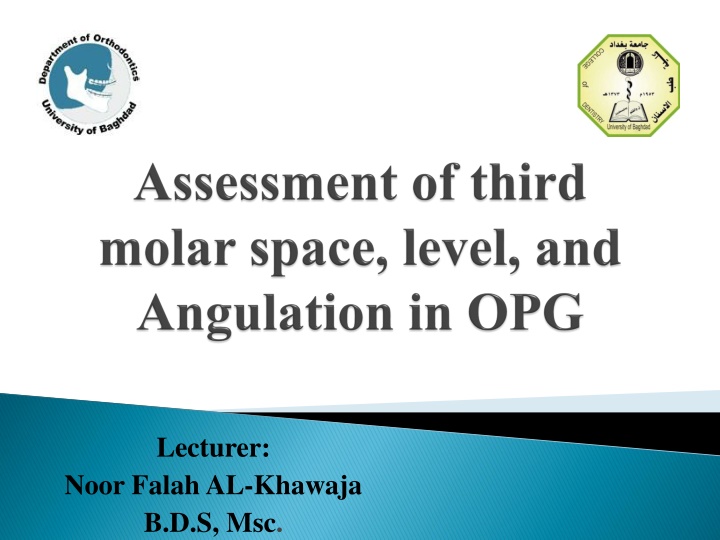
Factors Influencing Anterior Crowding in Orthodontics
Explore the multifactorial nature of anterior crowding in orthodontics, including the impact of wisdom teeth, third molars, and different studies finding correlations between crowding and various factors such as molar movement, extraction history, and more.
Uploaded on | 1 Views
Download Presentation

Please find below an Image/Link to download the presentation.
The content on the website is provided AS IS for your information and personal use only. It may not be sold, licensed, or shared on other websites without obtaining consent from the author. If you encounter any issues during the download, it is possible that the publisher has removed the file from their server.
You are allowed to download the files provided on this website for personal or commercial use, subject to the condition that they are used lawfully. All files are the property of their respective owners.
The content on the website is provided AS IS for your information and personal use only. It may not be sold, licensed, or shared on other websites without obtaining consent from the author.
E N D
Presentation Transcript
Lecturer: Noor Falah AL-Khawaja B.D.S, Msc.
1.Because Anterior crowding is a multifactorial problem. All Other causes that could be causing it must be assessed 2.The Width, Angulation and Eruption level of the wisdom teeth must be carefully evaluated
1. Bergstrom and Jensen study They have found that in both maxilla and mandible there was a greater degree of crowding on the side where the third molar was present. 2- Lindqvist and Thailander They noted that the space change on the extraction side was improve in relation to the control side in 70 percent of cases. ( (Sumitra Sumitra andTandur andTandur, 2005) , 2005)
3 Schwarze Study He found a significant forward movement of the first molars associated with increased lower arch crowding in the non-extraction group. 4 Selmer-Olsen's study He suggested that in people with unilateral congenital absence of a third molar there was less crowding. ( (Sumitra Sumitra andTandur andTandur, 2005) , 2005)
1- Ades Study He studied four groups. One with missing third molars. The second were impacted. The third were erupted and functional. The fourth extracted at least 10 years before the post retention records. No significant differences were found in mandibular growth or Lower labial segment between any of the subgroups. ( (Sumitra Sumitra andTandur andTandur, 2005) , 2005)
2- Harradine study heevaluatedtheloweranteriorcrowdingrelapsein thepatient undergoingorthodontictreatmentand thedifferencewasnot statisticallysignificant. ( (Gopalasamy Gopalasamy et.al., 2020) et.al., 2020) 3-LittleRM In his study he observed that 90% of the extraction cases undergoingorthodontictreatmentstillendedup withlower anteriorcrowding ( (Gopalasamy Gopalasamy et.al., 2020) et.al., 2020)
Long axis of the second molar: It was drawn extending from the mid-occlusal point and midpoint of root bifurcation of the second molar (Sood et.al., 2018) ANS point; HRP, horizontal reference plane; LC, line at cervical level of molar bud; MOP, mid ANS, anterior nasal spine; point; HRP, horizontal reference plane; LC, line at cervical level of molar bud; MOP, mid- -occlusal , anterior nasal spine; BiP BiP, bifurcation , bifurcation plane. occlusal point; OP, point; OP, occlusal occlusal plane
Long axes of the third molar buds: It was traced as the perpendicular bisector of a line connecting outlines of the most mesial and distal cervical areas.
OP: It is the line joining the tips of most superior cusps of the first premolar and tip of most superior mesial cusps of the second molar. A perpendicular line touching the most distal point of the second molar crown was also drawn from OP.
HRP: Nasal septum and ANS were marked, and line joining them was traced and bisected. A perpendicular line to this midline bisector extending bilaterally through palatal shadow was drawn, termed as horizontal reference plane.
1) Eruption Space (Ganss, 1993; Sood et.al., 2018) Available space: It was measured as distance between intersection of OP with anterior border of ramus and intersection of line perpendicular to the OP from distal most aspect of second molar. (Line A) Third molar crown mesiodistal width: It is the length of the line connecting most mesial and distal outlines of the third molar crown. (Line B) Ganss ratio: The ratio of line A to B, that is, available space/third molar crown mesiodistal width
the Ganss ratio used to evaluate space If the ratio values are > 1, 70% of teeth would gradually enter into the arch. Lower values indicated probability of impaction.
2. Eruption Depth :- was calculated as depth of the third molar in relation to the neighbouring second molar Level A (fully erupted) group: Same level as or above the OP of the adjacent second molar. Level B (partially erupted) group: Below the OP but above the cementoenamel junction (CEJ) of the second molar. Level C (unerupted) group: Beneath the CEJ of the second molar.
Third molar angulation with second molar: It is the angle formed by the long axis of the mandibular third molar and long axis of the mandibular second molar. Third molar angulation with OP: It is the angle formed between OP and the long axis of the third molar. Third molar angulation with HRP: It is the angle formed between the HRP and long axis of the mandibular third molar
The development of space for the third molar is affected various factors, including: 1. backward slope of anterior border of ramus in relation to the alveolar border. 2. resorption of bone from anterior border of ramus. 3. forward movement of dentition. 4. growth in length of the mandible. 5. sagittal direction of mandibular growth. 6. sagittal direction of eruption of dentition. Hattab Hattab and and Alhaija Alhaija, 1999 , 1999
The role of the third molar still is a debatable issue despite multiple attempts to resolve its role in late anterior crowding. Further detailed studies are also required to assess correlation between lower anterior crowding and third molar eruption depth, angulation and space in different skeletal malocclusions, and also in different facial morphologies, including large sample size.
